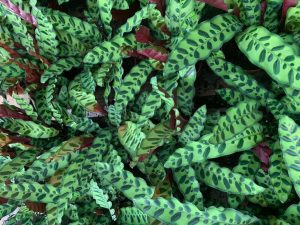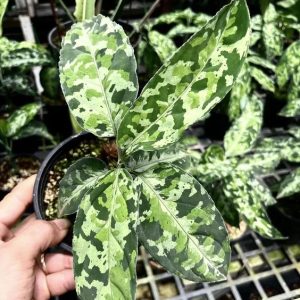The green prayer plant is especially great curiosity for its leaves that open and shut in circadian rhythm; the Maranthus species is renowned for its unusual leaf texture and colour variants. Understanding their ideal lighting conditions helps one to guarantee that these plants stay attractive and healthy in an indoor atmosphere.

Maranta Green Prayer Plant
Maranta Green Prayer Plant Natural Habitat and Lighting Practices
Native to South American rainforests, where year-round consistent light conditions, high humidity, and mild temperatures define the environment, the green prayer plant is Usually growing in the understory of the rainforest habitat, green prayer plants are used to indirect light instead than direct sunshine.
The thick canopy of the understory habitat screens most of the sunshine, and only diffused light may reach the ground. The Maranthus species would find a favourable growing habitat in this homogeneous and mild light. Thus, it is rather helpful to replicate this soft diffuse light situation for its development when growing the green prayer plant.
Plant Basic Green Prayer Lights:
Green prayer plants need some light to preserve their vivid leaf colour and good development even if they can live in less light settings. Generally speaking, the following sums up the minimum light needs of green prayer plants:
Bright diffuse light is the most perfect light environment for green prayer plants. Transparent curtains or blackout fabric on the windows will help you to guarantee that the light does not directly beam on the plant’s leaves.
Steer clear of direct sunshine even if green prayer plants need it; particularly intense sunlight at midday may cause leaf burns or colour fade-off. It is therefore rather crucial to prevent long-term direct sunlight exposure of the plant.
Green prayer plants are very adaptive to variations in light, although inadequate light could result in delayed development and poor leaf colour. Thus, in a location lacking enough light, take into account adding artificial illumination to augment the natural one.
Lighting arrangement suitable for Maranta green prayer plants
The light needs of green prayer plants allow one to design perfect growth conditions for them inside. These are some typical ideas for lighting environment settings:
Usually offering mild natural light, north-facing windows are very fit for arrowroot plants. This posture guarantees that the plant gets sufficient light without direct sunlight’s presence.
East-facing windows provide mild light in the morning; west-facing windows give bright light in the evening. Green prayer plants may profit from suitable light by means of somewhat sun shielding.
Blackout curtains or transparent curtains help to provide gentle light and lower the intensity of direct light in a room with plenty of sunshine.
Indoor artificial lighting: Plant growth lights may be utilised to augment the light if the green prayer plant is situated in a room with inadequate illumination. These lights replicate the spectrum of natural light, therefore supporting the photosynthesis and normal development of the plant.
How light affects the green prayer plant leaves?
Apart from influencing the health and development rate of green prayer plants, light significantly alters the colour and texture of their leaves. The following are some salient features of the interaction of light conditions with plant leaves:
Leaf colour: Appropriate light may improve leaf colour contrast and provide more unique feel. The colour of the leaves could go dull or even yellow in poor light.
The green prayer plant’s leaves typically are thick and lustrous under enough diffuse light. Should the light be inadequate, the leaves might get thinner and the texture may get brittle.
Green prayer plant leaves open and shut in line with circadian rhythm, a phenomena known as “praying behaviour”. Regularity and stability of this behaviour may be changed by variations in light circumstances. While too strong or too faint light may disturb the process, enough light may maintain the leaves opening and closing properly.
Seasonal light modification
Seasonal light change is required to maintain the green prayer plant growing healthily as the seasons vary the light conditions.
Spring and summer: The sun is greater in these seasons, so the green prayer plant may be put in a quite light-less area or shaded to help to shield from great light damage.
Autumn and winter: The daylight hours are decreased and the light intensity is dropped in autumn and winter. Think about transferring the plant to somewhere with more light or adding artificial light to augment the natural one.
Maintaining a consistent sunshine length is very crucial for the growth of green prayer plants. Using a timer to regulate artificial lighting’s on and off times in winter will help to replicate the long summer days and preserve plant photosynthesis efficiency.
The link among light and other environmental elements
There are other elements influencing the development of green prayer plants besides light. It cooperatively influences plant health by interacting with environmental factors like temperature, humidity, and ventilation.
Temperature and light: The requirement for light of the plant will vary depending on either too high or too low temperatures. While in a low temperature setting a suitable increase in light may assist sustain the plant’s metabolic activity, in a high temperature environment plants may require more diffuse light to prevent too much photosynthesis.
Maranta plants like a high humidity surroundings. Low humidity would cause the leaves to lose their gloss; so, increasing light intensity could worsen this issue. Thus, it is important to maintain appropriate humidity in a surroundings with bright light.
Good ventilation lessens the incidence of fungal infections and helps avoid leaf burns brought on by too strong light.
Typical light issues and fixes
Even if you are aware of the low light needs of green prayer plants, real growing may present some light issues. These are a few typical issues along with their fixes:
Yellowing foliage: Should the green prayer plant leaves become yellow, either too little or too much light might be responsible. To change the light, you may try moving the plant’s location or using a shadow cloth.
If brown or burned areas show up on the leaf margins, direct sunlight might be the source of burns. Right away move the plant to a soft light location and cut off the damaged leaves.
Insufficient light might lead to delayed or stationary development of the plant. In this situation, you may relocate the plant to a spot with more light or raise the light intensity using a plant growth lamp.
Among the arrowroot plants, green prayer plants are favoured for their unusual leaf form and circadian rhythm. Suitable light conditions help to guarantee their good development in an indoor setting. Understanding the native habitats and light patterns of these plants as well as how to provide appropriate light conditions for them in various surroundings helps gardeners to properly avoid frequent cultivation issues and maintain plants in best shape.

Maranta
Maranta Green prayer plants may provide the surroundings special beauty and natural environment whether in public greening or personal gardening. By means of logical and scientific light control, these exquisite plants will remain appealing and transform into a lovely backdrop for human life.
Post time: 08-23-2024




